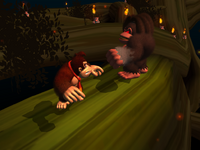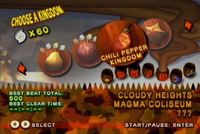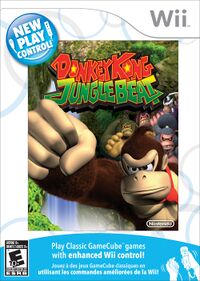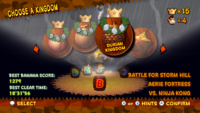Donkey Kong Jungle Beat: Difference between revisions
mNo edit summary |
m (→Enemies) |
||
| Line 106: | Line 106: | ||
*[[Hawg]]s | *[[Hawg]]s | ||
**[[Gale Hawg]] | **[[Gale Hawg]] | ||
**[[ | **[[Nap Butapoppo]] | ||
**[[ | **[[Tusk Butapoppo]] | ||
**[[ | **[[Fire Butapoppo]] | ||
*[[Yukimogura]]s | *[[Yukimogura]]s | ||
*[[Black Butapokkī]]es | *[[Black Butapokkī]]es | ||
Revision as of 11:06, October 13, 2012
Template:Infobox Donkey Kong Jungle Beat is a platformer for the Nintendo GameCube (later ported to Wii) starring Donkey Kong. It is different from most other platformers in that the DK Bongos can be used as the controller, but the game can also be played with the normal controller. The game was developed by a division of Nintendo EAD, who would later develop games such as Super Mario Galaxy.
Not counting the earlier arcade ports to the NES and other systems, Donkey Kong Jungle Beat was the first console/handheld Donkey Kong game to not be made by Rare Ltd. After they left Nintendo and joined Microsoft, Rare lost control of the Donkey Kong series due to the fact that it was trademarked by Nintendo. Due to this, Jungle Beat was very different than the Donkey Kong Country games in gameplay, characters, and, perhaps most notably, the personality of Donkey Kong, who is more aggressive than in past titles.
Story
Story From Instruction Booklet:
One day, the peace of the jungle was disrupted by a rampaging pack of wild baddies who wreaked havoc on the residents of the jungle.
Not only that, but they laid claim to every kingdom and stole each one's precious bananas!
"This calls for the one and only Donkey Kong!"
Join forces with your jungle buddies to face an array of powerful enemies and restore peace to the jungle!
Story from Nintendo website (New Play Control!):
Donkey Kong sets out to prove he's king of the jungle and beyond. He rampages through lava caves, savage seas and crazy locales like a ninja-chimp fortress. Only when Donkey Kong defeats all the kings of his world – by boxing with apes, rabid warthogs, ballistic elephants and giant birds – can he call himself king.
Story from European website (New Play Control!)
When an army of invaders infiltrate Donkey Kong’s jungle home and help themselves to every banana they can get their hands on, you know there’s going to be trouble. With a rumbling stomach and the support of some fellow banana-starved buddies, the agitated ape sets out to reclaim what’s rightfully his and liberate the kingdoms he passes through in the process.
During the events of the game, the jungle and various fruit kingdoms are overrun by Ghastly King and Cactus King, with each kingdom being ruled by one of their minions. The jungle's bananas are also stolen and hidden in each kingdom. Now, the only one who can save the jungle and the kingdoms from the tyrannical rulers is Donkey Kong.
During his journeys, in which he defeats the kings in each kingdom, Cactus and Ghastly King both claim to rule the world. However, their plans are thwarted when Donkey Kong arrives and beats Cactus King, and later Ghastly King. The Helper Monkeys and Ninjapes, as well as the four Kongs under Ghastly King and Cactus King, then celebrate the defeat of the duo.
In the original GameCube version, the game had little story behind it. It was stated by game director Yoshiaki Koizumi that Donkey Kong simply wanted "[...]to be the best, and to become the king of the jungle."[1]
Characters
Main
Animal Buddies
Other
- The Chopperbird
- Three turtles
Bosses
|
The Kongs |
The Tusks |
The Rocs |
The Hogs |
Enemies
|
Gameplay
The controls of Donkey Kong Jungle Beat are different from most 2-D platformers, in that the player can not only use the GameCube controller but also the special DK bongos. Hitting the left bongo repeatedly will send Donkey Kong running to the left, and hitting the right will send him right. To jump straight into the air, the player must hit both bongos at once. To jump diagonally, the player must hit the bongo in the direction he or she wants to jump, while using the other bongo to run. When the player is on an animal buddy, The player can control Hoofer by pounding the right drum to make him run faster, he/she can control Helibirds by pounding each of the drums to fly in that direction, and both drums, one after another, to fly in a mostly straight upward line, and the player can control Flurl by pounding each drum to descend in that direction, and both to descend in a straight line, but slowly. To use the Sound Wave Attack, the player must clap, but he/she may also hit the side of the bongos. During most boss fights or while fighting certain enemies, the player can punch the bosses by pounding the bongos.
The GameCube controller controls are more simplified; the actions performed by the bongos are mostly incorporated into the ![]() . To move, the player must tap the
. To move, the player must tap the ![]() in the desired direction in order to move Donkey Kong. To jump, the player must press the
in the desired direction in order to move Donkey Kong. To jump, the player must press the ![]() or tap the
or tap the ![]() upwards, and to move in midair, the player must tap the
upwards, and to move in midair, the player must tap the ![]() in the desired direction. To punch, the player must tap the
in the desired direction. To punch, the player must tap the ![]() back and forth repeatedly. Moving Helibirds, Flurl, and Hoofer can be achieved once again by tapping the
back and forth repeatedly. Moving Helibirds, Flurl, and Hoofer can be achieved once again by tapping the ![]() . The sound wave attack can be used by tapping
. The sound wave attack can be used by tapping ![]() .
.
In the Wii version, the controls are completely different. To move, the player must tap the ![]() on the
on the ![]() . The sound wave attack can be used by shaking the
. The sound wave attack can be used by shaking the ![]() . Pushing
. Pushing ![]() will allow the player to punch, jump, and perform any other actions required by the button.
will allow the player to punch, jump, and perform any other actions required by the button.
The game also differs from most others in that the goal is to get to the end while also trying to collect as many beats as possible. These beats act as health during a level and during the boss battle. In the New Play Control! version, beats are only used as health during boss battles; hearts replace beats as health during levels. By using combos, which are obtained by performing a special action (backflips, ground pounds, riding an animal buddy, etc.), Donkey Kong can earn more beats than he would by simply running into them. The combo can continue as long as Donkey Kong is airborne and ends when he hits the ground; the number of beats collected during the combo is then added to the total. Combos can only be earned by performing several consecutive and different actions. Each combo increases the amount of beats earned by simply collecting a banana by the combo number (i.e. running into one banana at a combo ten increases the beat total by ten). By using a special technique called a clap grab, the player can collect all the beats in a general area with once move, which also increases the beat count by a greater number then by simply running into them individually.
Donkey Kong Jungle Beat contains a total of 19 Kingdoms (21 in the New Play Control! version), each one being named after a fruit, with the only deviators being the VS. areas, Opening Ceremony, Kong of the Mountain, and Banana Banquet (both of which are only playable in the New Play Control! version). Each Kingdom is selected by choosing one of six "barrels", with each barrel containing four kingdoms, but in the GameCube version, the moon barrel only has two kingdoms, and Opening Ceremony is in its own barrel; also, in the New Play Control! version, each barrel only has three kingdoms until the fourth is unlocked.
Every kingdom contains three levels: two standard levels, followed up by a boss battle. The only levels that stray from this pattern are the VS. areas, which each only have one level and then a boss battle; in the New Play Control! version, there are two more Kingdoms exclusive to this version: Banana Banquet, which is only one level, and Kong of the Mountain, in which the player must fight the five Kong bosses and Ghastly King. At the end of each level is a fruit, which DK must bite into to complete a level. The player can then play a minigame involving attempting to eat as many bananas as possible in a few seconds; the player then receives extra beats based on the number of bananas eaten. In the New Play Control! version, each heart left also gives the player fifty additional beats.
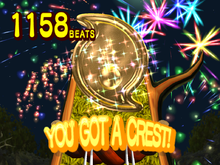
Occasionally, the player must play an individual level riding Hoofer the Wildebeest. These levels involve running into frozen beats to collect them, as well as dodging enemies by jumping over them as Hoofer charges toward the fruit at the end of the level. Hoofer may also appear near the fruit at the end of other ice levels. After the fruit, one of two minigames is played riding Hoofer:
- If Hoofer is played as throughout the entire level, the minigame at the end involves gaining as much momentum as possible by jumping off a ramp into the air and flying as far as possible. By using the DK Bongos, the player can slam on the right drum to fly farther. Not jumping off a ram at all results in Hoofer simply flying off the ramp in an uncontrollable spiral. As soon as the player lands, the beat total is counted by using the distance total.
- If Hoofer is found at the end of a level, the minigame played involves jumping over a series of platforms, ending at twenty. Once the player falls or reaches the end, the total is counted, by multiplying the number of successful jumps times ten. Between each platform is two beats flying on top of each other, and every tenth platform has a group of four beats floating between it and the next one. At the end of Asteroid Belt, Iguanagon appears as an optional enemy. Additionally, the floating beats are replaced with Rocs.
As stated above, at the end of each kingdom is a boss level, in which Donkey Kong faces one of four types of bosses: a Kong, a Roc, a Hog, or a Tusk. Each species has a different fighting style and requires a different method to defeat, but the goal is to defeat the boss without losing too many beats, for these beats are necessary in earning crests. These crests are used to unlock new kingdoms, as each one can only be unlocked when a certain number of crests have been obtained. However, in the New Play Control! version of the game, kingdoms are unlocked after the previous kingdom has been completed, and collecting all the crests in one barrel results in a fourth kingdom being unlocked.
At the end of each kingdom, DK throws a barrel containing his beats into the Sacred Tree, allowing him to obtain up to four crests. The totals to obtain each crest are as follows:
- Below 400 - Bronze crest
- 400 - Silver crest
- 800 - Gold crest
- 1200+ - Platinum crest
In the New Play Control! version, this is changed to only gaining up to 3 crests, each one looking exactly the same but worth different amounts of beats.
- 200 - One crest
- 500 - Two crests
- 1000+ - Three crests
Kingdoms and Bosses
- Opening Ceremony
- D Barrel
- K Barrel
- Strawberry Kingdom - Mo-Hog (Gamecube), Fleet Roc (Wii)
- Pineapple Kingdom - Karate Kong
- Lemon Kingdom - Fleet Roc (Gamecube), Mo-Hog (Wii)
- Grape Kingdom - Grave Tusk (Gamecube), Hard Roc (Wii)
- J Barrel
- Cherry Kingdom - Hard Roc (Gamecube), Grave Tusk (Wii)
- Peach Kingdom - Torch Tusk (Gamecube), Bloat-Hog (Wii)
- Melon Kingdom - Bloat-Hog (Gamecube), Torch Tusk (Wii)
- Durian Kingdom - Ninja Kong
- B Barrel
- Moon Barrel (Final Bosses)
- VS. Cactus King (After Durian Kingdom)
- VS. Ghastly King (After Star Fruit Kingdom)
Sequels
Two Japan-only arcade sequels for Sega's Triforce were made:
- Donkey Kong: Jungle Fever (2005)
- Donkey Kong: Banana Kingdom (2006)
References to Other Games
- Donkey Kong: At the very beginning of the Cactus/Ghastly King battles, part of his theme song is a remix of the tune that plays when Donkey Kong climbs atop the construction site with Pauline.
- Donkey Kong Country: The entire concept of collecting bananas and riding Animal Buddies originated from this game. Also, Karate Kong bears a slight resemblance to Cranky Kong. Additionally, Barrels appear in the stage select menu, and the background music that's played in Dawn Savanna, after clearing clearing any boss stage, and the ending are remixes of the Jungle Hijinxs theme song.
References in Later Games
- Mario Kart DS: Many voice clips from Donkey Kong Jungle Beat were reused in this game.
- DK: Jungle Climber: Many voice clips were reused in this game as well. Also, the pose that Donkey Kong strikes after completing the bonus stage (where the player has to catch bananas with a barrel) is identical to the pose that he strikes in Jungle Beat after completing the banana-eating bonus at the end of each stage.
- Super Mario Galaxy: There were a few gameplay mechanics from Donkey Kong Jungle Beat that were reused in this game, including sound effects. Also, Party Monkeys and Haribonbons were originally going to appear as enemies in this game.
- Super Smash Bros. Brawl: Rumble Falls was a default stage that could be selected in the game, and the background would also change rapidly, with one of them being the background that was used in the Sky Garden stage. Also, the song, "Battle For Storm Hill", in its original form, could be selected as background music for that stage and custom stages. Lastly, the Party Monkey, Gale Hawg, Hoofer, Karate Kong, and Donkey Kong's appearance in this game appeared as Stickers, and Helibird and Turrent Tusk appeared as Trophies.
New Play Control!
The game has been remade for the Wii in the "New Play Control!" selection. It was released in Japan on December 11, 2008[2], North America on May 4, 2009, and in Europe on June 5, 2009. The game is played with the Wii Remote and Nunchuk[2], offers a wide-screen mode,[3] and several changes to the levels as well. Gimmicks and enemies may be found at different places than the original game. There are no completely new levels, but there are two new locations in the Kingdom selection screen: a Boss Battle Run-Trough[2] and the Ceremony stage from the GameCube version[2].
Donkey Kong is controlled with the Analog Stick of the Nunchuk, and to clap the player has to flick the Wii Remote. Unlike the original game, Donkey Kong's claps can face different directions[2]. There are also new enemies, such as line-guided balls of electricity, and obstacles, like cacti[2]. The medal system has been revised - there are no longer different medals, but a number of medals (up to three for each kingdom) the player can win by getting a certain number of bananas[2]. Collecting all of the crests in one barrel results in the player unlocking the fourth kingdom in that barrel.
Other Changes
- An actual storyline, which wasn't present anywhere in the original game, not even the manual.
- Six different save files, unlike the original, which had only one per memory card.
- Bananas, or "Beats" as they were called in the original, are no longer used as an energy meter (except during boss battles). Instead, the player has three hearts as health. A life counter has also been added.
- The dancing panda bear was changed into a blue bear.
- Checkpoints have been added.
- Party Monkeys are scattered around various points of kingdoms to give the player advice.
- The Yukimoguras have been removed from Silver Snow Peak for unknown reasons, replaced with unknown obstructions.
- New types of enemies have been added
- Barrel Cannons have been added and are now used in the place of the Banande Lions from the original.
- Donkey Kong now wears a crown after defeating a boss. The crown could also be worn in the stages after the player completes the game with all crests and crowns.
- There are now 60 crests instead of 72, and they no longer have a variety of different colors, as every one of them have been changed to silver/platinum.
- Some boss and level locations were moved to different kingdoms.
- Donkey Kong can no longer use Clap Grabs underwater and/or in the air (while using Animal Buddies such as Helibird or Flurl).
- The Karate Kong battle is shown from a different camera angle while Donkey Kong is punching.
- Due to closer camera angles, Donkey Kong is no longer shown at the bottom left-hand corner of the screen.
- Opening Ceremony can no longer be selected once the player has completed it.
- During Opening Ceremony, Donkey Kong may also save various Party Monkeys trapped inside bubbles by using the Sound Wave Attack.
- Stacks of logs have been added to various parts of levels.
- Beats have been added at various points.
- Kingdoms are unlocked after the previous one has been completed.
New Kingdom and Barrel Locations
In the New Play Control! version, there are three kingdoms per barrel, with a fourth one that has to be unlocked by obtaining all nine crests in the first three. The unlocked kingdoms are the kingdoms that were originally in the B-barrel from the original game. The order they appear in is as follows:
- D Barrel
- Banana Kingdom
- Orange Kingdom
- Watermelon Kingdom
- Pear Kingdom (unlockable)
- K Barrel
- Apple Kingdom
- Strawberry Kingdom
- Pineapple Kingdom
- Lychee Kingdom (unlockable)
- J Barrel
- Lemon Kingdom
- Grape Kingdom
- Cherry Kingdom
- Chili Pepper Kingdom (unlockable)
- B Barrel
- Peach Kingdom
- Melon Kingdom
- Durian Kingdom
- Star Fruit Kingdom (unlockable)
- Moon Barrel
- VS. Cactus King
- VS. Ghastly King
- Kong of the Mountain*
- Banana Banquet*
* - These stages only appear in the New Play Control! version.
Reception
Donkey Kong Jungle Beat received mainly positive reviews. Rated the 95th best game made on a Nintendo system in the Top 200 Games List by Nintendo Power in its February 2006 issue, the game's main criticism was its short length and departure from the classic Donkey Kong Country gameplay.
Gallery
Quotes
- Main article: List of Quotes in Donkey Kong Jungle Beat
Beta Elements
- Main article: Donkey Kong Jungle Beat/Beta elements
Staff
- Main article: Donkey Kong Jungle Beat/Staff
Trivia
- This was the first video game to be rated E10+ by the ESRB.
- Donkey Kong Jungle Beat, so far, is the only New Play Control! series game to have new content.
External Links
- Japanese Site
- European English (New Play Control!) Site
- New Play Control! Donkey Kong Jungle Beat at Nintendo
- Japanese New Play Control! Site
References
- ^ Review at IGN.com
- ^ a b c d e f g WiiFolder » Blog Archive » Video Demo - Donkey Kong Jungle Beat, accessed 2009-01-12
- ^ Gametrailers.com - Donkey Kong Jungle Beat - Japanese Debut Trailer *No Sound*, trailer of the Wii version
